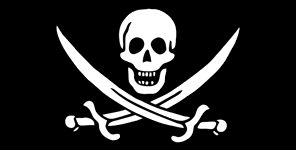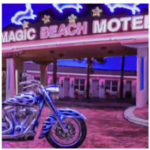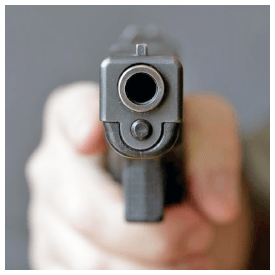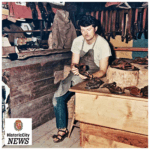 Pirate treasure rumors
Pirate treasure rumors
Do secret rooms conceal unknown treasures?
By Geoff Dobson
Rumors take on a life of their own and ultimately cause hurt or expense. Who has not heard the rumor which has been going on in St. Augustine that Six Flags is coming to St. Johns County and will be constructed off of State Road 206?
Indeed, there was a fear that when the County authorized a sewer line to serve the rest area on I-95, that it was really intended to serve the future park. The County actually had to defend its plans for the rest area in court as a result
Although the rumor goes back to the 1970’s, only last year, the writer was told that plans for the possible improvement of Cracker Swamp Road were because it was going to serve the main rear entrance to the Park.
It requires a vivid imagination to picture Cracker Swamp Road as the main entrance to anything.
Then there was the rumor that the Ponce de Leon Lodge was to be purchased by Disney to serve as a preview center for Disney World.
When the U.S. Mint began coining various state-based quarters, there was a rumor that the North Carolina quarter was going to be withdrawn from circulation because of an error. Therefore, one should hold on to your North Carolina quarters, they would become collector items.
Most fascinating, however, are rumors of lost treasure. The stories often have to do with lost maps, secret tunnels, and secret rooms.
What young boy has not relived through the pages of Robert Louis Stevenson’s Treasure Island a search for lost treasure which begins at Admiral Benbow’s Inn in Penzance on the Cornish Coast, a structure which indeed had secret tunnels leading to the harbour from both the fireplace and the well in the courtyard?
What cowboy has not thought about attempting to find Jack Slade’s booty allegedly hidden in Slade’s Canyon in a desolate area of Wyoming south of Lost Springs?
What prospector has not contemplated searching for the Lost Dutchman’s Mine in the trackless Superstition Mountains of Arizona?
The writer must confess to being a romantic and has ventured into the Superstitions, gone to Cornwall to view the smugglers’ caves, panned for gold in Alaska [It is backbreaking work], and hiked into box canyons north of Hanksville, Utah, and over an 800 foot high hill providing access to Whitewater Canyon, Arizona, where just possibly Butch, Sundance, and Kid Curry hid loot from various robberies.
Rumors are repeated so often that they become accepted as the truth. They are endlessly re-published, then are picked up by otherwise knowledgeable writers and find their way into scholarly works.
Recently, a number of museums and shops have opened or will open in St. Augustine devoted to St. Augustine’s alleged pirate history. A pirate has occasionally been spotted on St. George Street. What history there is of pirates in St. Augustine is scanty. It is true, that St. Augustine was attacked in 1868 by Captain Robert Searle. Searle was commonly referred to as a pirate, but more likely he was at the time a privateer seeking revenge for a Spanish attack on the Bahamas.
By the same token, however, the Spanish tended to regard all English captains as pirates. Thus, we find references to Sir Francis Drake as a pirate as well as references to Governors Moore and Oglethorpe as English pirates.
To denote one’s enemies as pirates seems to be a common practice. In negotiations with Britain relating to the devastation wrought upon Union shipping by the Confederate States Navy, the State Department referred to the CSS Florida and the CSS Alabama as “pirate ships.”
This is not to say that there were no pirates in Florida, French pirates twice raided the great Spanish hacienda de La Chua near present day Gainesville and owned by the heirs of Don Pedro Menéndez, the founder of St. Augustine. Once the pirates rowed up the Suwannee and Santa Fe Rivers and captured Don Tomas Menéndez Márquez, the then owner of the rancho and held him for ransom. A second time the French pirates came in from the Withlacoochee River near present-day Yankeetown.
With all the new pirate museums and shops, the old rumor repeated by several writers of Jose Gaspar’s buried treasure on Anastasia Island will probably again flourish. See Kramer, Jeffrey, and “Florida’s Fabulous Treasures.” We will all charge out with our metal detectors, shovels, and a map seeking Jose Gaspar’s lost treasure.
It will be like the periodic rush to Fowlers Bluff southwest of Chiefland. The rush usually begins with an article in a newspaper or in the National Geographic. The legend in Fowlers Buff is that nearby is buried two barrels containing the lost treasure of Alexander Arbuthnot and Robert Ambrister who were hanged by Andrew Jackson for trading with the Indians.
Others contend that the treasure is the lost treasure of the pirates Jean and Pierre Lafitte. Periodically, various hunters waste their own treasure in a vain search for the lost treasure.
Another rumor relating to Fowlers Bluff is that over a hundred years ago, a Scandinavian pirate, down on his luck, gave lumberman Emmett Baird a map showing where Lafitte’s treasure trove was buried. Baird engaged in a three month search before announcing that he was giving up the treasure. Shortly thereafter Baird began making large investments in Baird’s Hardware Store in Gainesville. Rumors abounded that the investments were made from proceeds of the treasure and the balance was hidden in his Gainesville mansion.
Twenty years ago, the then owners of the mansion gutted it. No treasure was found. The question must be asked however, if Baird found the treasure, why is everyone still digging up Fowlers Bluff?
The reports relating to the lost Jose Gaspar treasure give precise directions as to where it may be found. It is on Anastasia Island, three hours walk south of the St. Augustine Inlet, south of Matanzas Inlet. There is somewhat of a conflict in the directions. Anastasia Island is north of Matanzas Inlet. Of course, there is no agreement as to the actual existence of Jose Gaspar or whether it is a nice story told as the basis for Tampa’s Gasparilla Celebration much like the legend of Sara De Soto as being for the inspiration for the naming of Sarasota Bay.
Nevertheless, St. Augustine does have its secret rooms which may have been used to hide treasure.
About twenty years ago, a local air conditioner contractor was installing central air conditioning in an older house in the Lighthouse Park area of St. Augustine. The air return was to be installed below the stairway to the second floor. In cutting into the wall, the contractor discovered a secret room of which the then owners were unaware.
The secret room could be reached only from a trap door in the floor of the kitchen closet, down a stairway leading to a hidden cellar. From a crawlspace leading from the cellar, one could lift another trap door which led up to the secret room.
What treasures were hidden there? Only a few old Playboy Magazines — apparently placed there by the former owners’ teen-aged boys.
Geoff Dobson, a St Augustine resident for the past 33 years, is a western and Florida history writer and was former General Counsel for the Florida Department of Transportation. He is a former president of the St. Augustine Historical Society and a regular contributor of nostalgic memories to Historic City News. Before his parents moved to Florida, his father was a Black Angus cattleman. Geoff has written extensively on Wyoming history (“Wyoming Tales and Trails”). When Geoff was in high school, his family lived in the cattle country of eastern Sarasota County. The family spread, which his parents called “Wild Cat Slough,” was reachable only by a pair of ruts over the sand hills and through a snake and gator infested slough. Now, it is an area of four-lane roads, expensive subdivisions, shopping centers, and office parks. . His undergraduate degree is in history. Geoff received his post-graduate degree from the University of Florida. He may be reached at horse.creek.cowboy@gmail.com
Discover more from HISTORIC CITY NEWS
Subscribe to get the latest posts sent to your email.






Comments are closed.